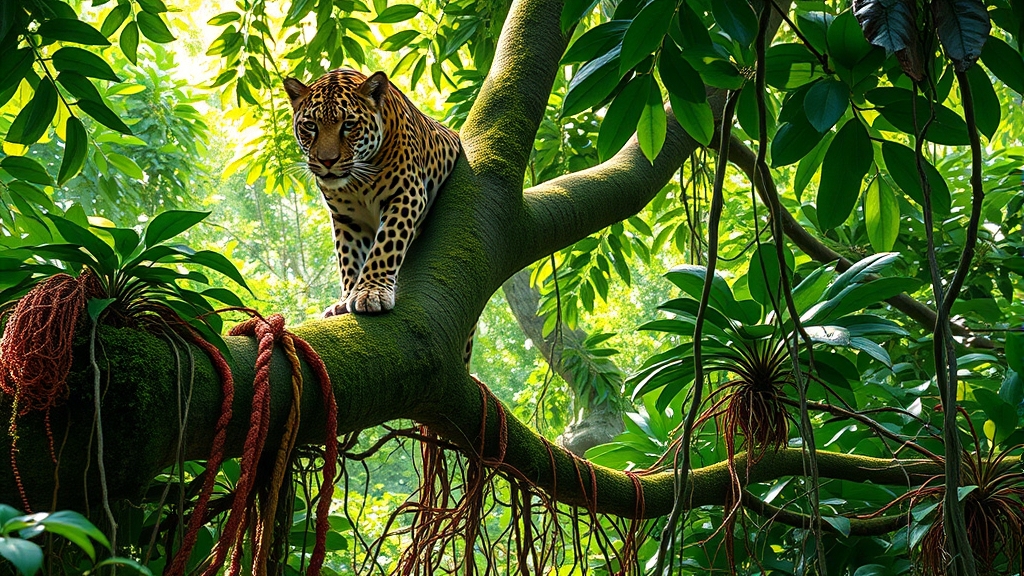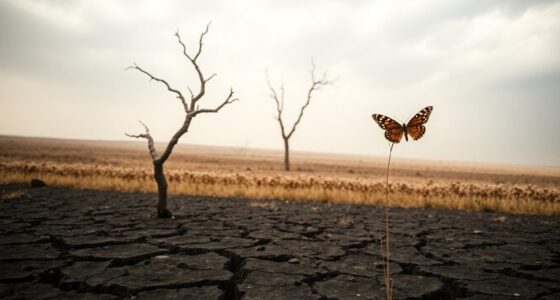Keystone species play a vital role in ecosystems by regulating populations and maintaining balance within the food web. Their presence prevents overgrazing and habitat destruction, helping to preserve biodiversity. When these species are removed, it can cause ripple effects known as trophic cascades, destabilizing the entire community. Understanding how keystone species influence their environment reveals why protecting them is essential. Keep exploring to discover more about their critical impact on ecological health.
Key Takeaways
- Keystone species maintain ecosystem structure by regulating populations and preventing overgrazing or habitat destruction.
- Their presence influences resource availability, supporting biodiversity and overall community stability.
- Removing keystone species can trigger trophic cascades, leading to ecosystem imbalance and species loss.
- They act as ecological regulators, shaping the web of life and ensuring energy flow across trophic levels.
- Protecting keystone species is vital for conserving ecosystem health, resilience, and biodiversity.

A keystone species plays a crucial role in maintaining the structure and health of an ecosystem. Without this species, the entire community can change dramatically, often leading to a loss of biodiversity and stability. Your understanding of how keystone species influence their environment reveals that they do more than just exist; they actively shape the web of life around them. One way they do this is through processes called trophic cascades, which occur when the presence or absence of a single species causes ripple effects across multiple levels of the food chain. For example, removing a top predator often results in an overpopulation of herbivores, which then overgraze plants and cause habitat destruction. This imbalance can destabilize the entire ecosystem, emphasizing the importance of keystone species in preserving ecological balance. The meaning of aura colors can also reflect the health and stability of an ecosystem, highlighting the interconnectedness of all living systems.
You might think that only the most obvious animals, like wolves or sea otters, are keystone species, but they’re just part of a bigger picture. These species regulate populations and influence the availability of resources, creating a chain reaction that sustains the environment. When a keystone predator is present, it keeps herbivore numbers in check, preventing overgrazing and allowing plants and smaller animals to thrive. This, in turn, supports a diverse array of species, maintaining a healthy, resilient ecosystem. Conversely, removing such a predator can cause trophic cascades that lead to habitat degradation and reduced biodiversity. Recognizing the impact of species interactions helps clarify how interconnected ecological roles are and underscores the importance of keystone species in maintaining balance. The ecological balance relies heavily on these key players, who act as regulators and stabilizers. Additionally, the health of an ecosystem can be assessed by observing the presence of indicator species, which serve as indicators of ecological integrity.
Your role in understanding keystone species isn’t just academic; it’s practical. Protecting these species can safeguard entire ecosystems from collapse. They serve as linchpins that hold ecological communities together, ensuring that energy flows correctly and that populations remain balanced. Understanding ecosystem stability can also improve conservation strategies, making efforts more targeted and effective. Recognizing the importance of keystone species highlights the interconnectedness of life and underscores the need for conservation efforts. When you appreciate how trophic cascades work, you realize that preserving keystone species isn’t just about saving individual animals—it’s about maintaining the intricate web of relationships that support life on Earth. Their presence ensures that natural systems continue to function properly, providing the stability necessary for ecosystems to adapt to changing conditions and sustain diverse life forms over time.
Frequently Asked Questions
How Are Keystone Species Identified in Different Ecosystems?
When you identify keystone species in different ecosystems, you start with trophic analysis to see their influence on food webs. You observe how their removal affects the habitat impact, often noticing significant changes in species diversity or ecosystem stability. These species typically have a disproportionate effect relative to their abundance. By studying these dynamics, you can pinpoint which species play critical roles in maintaining ecosystem balance and health.
Can a Species Lose Its Keystone Status Over Time?
You might wonder if a species can lose its keystone status over time. Yes, a species’ role in maintaining ecological stability can change due to factors like environmental shifts or interactions with other species. If its influence diminishes, it may no longer be considered a keystone. Monitoring these changes helps you understand ecosystem dynamics and the importance of species roles in preserving balance.
What Are Examples of Keystone Species in Marine Environments?
You might think marine environments are endless, but keystone species are essential to their balance. Examples include sea otters, which control sea urchin populations, preserving coral reef dynamics, and large predatory fish that influence marine predator impacts. These species keep ecosystems from turning into chaos, demonstrating their irreplaceable role in maintaining marine biodiversity and stability. Without them, the marine world would be unrecognizably different and far less vibrant.
How Do Keystone Species Influence Biodiversity Beyond Their Immediate Habitat?
You see that keystone species influence biodiversity beyond their immediate habitat by maintaining ecosystem stability through their actions. When they change population sizes, trophic cascades occur, affecting multiple species across different habitats. By regulating prey or competitors, they help preserve diverse communities, ensuring the overall health of ecosystems. Their impact extends far beyond their local environment, shaping the structure and resilience of ecosystems on a broader scale.
What Are the Risks of Removing a Keystone Species From an Ecosystem?
Imagine disrupting a delicate clock; removing a keystone species can throw ecosystem balance into chaos. You risk triggering species extinction, as the intricate relationships holding the ecosystem together unravel. Without this key player, prey populations may explode or decline, harming other species. The loss can cascade, leading to diminished biodiversity and an unstable environment. Fundamentally, removing a keystone species threatens the entire ecosystem’s health and resilience.
Conclusion
Just like the mighty Hercules who shaped legends, keystone species shape their ecosystems, holding everything together. Without them, chaos could reign, much like the mythic chaos of the Titans’ fall. By understanding their essential role, you realize how delicate balance truly is—reminding us that even the smallest players can have the greatest impact. Protecting these species is like safeguarding a hidden treasure; it ensures nature’s harmony endures for generations to come.





